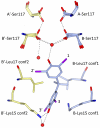Tetrabromobisphenol A Is an Efficient Stabilizer of the Transthyretin Tetramer
- PMID: 27093678
- PMCID: PMC4836675
- DOI: 10.1371/journal.pone.0153529
Tetrabromobisphenol A Is an Efficient Stabilizer of the Transthyretin Tetramer
Abstract
Amyloid formation of the human plasma protein transthyretin (TTR) is associated with several human disorders, including familial amyloidotic polyneuropathy (FAP) and senile systemic amyloidosis. Dissociation of TTR's native tetrameric assembly is the rate-limiting step in the conversion into amyloid, and this feature presents an avenue for intervention because binding of an appropriate ligand to the thyroxin hormone binding sites of TTR stabilizes the native tetrameric assembly and impairs conversion into amyloid. The desired features for an effective TTR stabilizer include high affinity for TTR, high selectivity in the presence of other proteins, no adverse side effects at the effective concentrations, and a long half-life in the body. In this study we show that the commonly used flame retardant tetrabromobisphenol A (TBBPA) efficiently stabilizes the tetrameric structure of TTR. The X-ray crystal structure shows TBBPA binding in the thyroxine binding pocket with bromines occupying two of the three halogen binding sites. Interestingly, TBBPA binds TTR with an extremely high selectivity in human plasma, and the effect is equal to the recently approved drug tafamidis and better than diflunisal, both of which have shown therapeutic effects against FAP. TBBPA consequently present an interesting scaffold for drug design. Its absorption, metabolism, and potential side-effects are discussed.
Conflict of interest statement
Figures





References
-
- Saraiva MJ, Magalhaes J, Ferreira N, Almeida MR (2012) Transthyretin deposition in familial amyloidotic polyneuropathy. Curr Med Chem 19: 2304–2311. - PubMed
MeSH terms
Substances
LinkOut - more resources
Full Text Sources
Other Literature Sources
Research Materials
Miscellaneous

